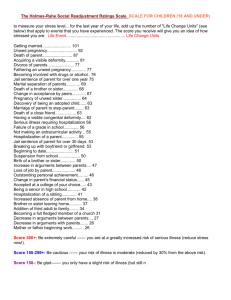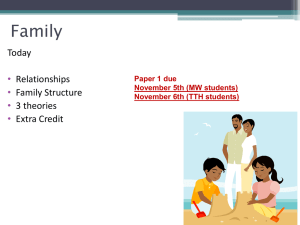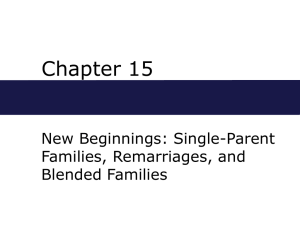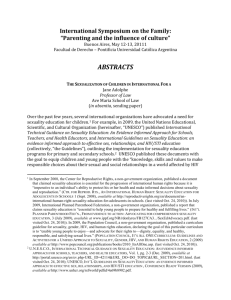Family Life Today PPT
advertisement
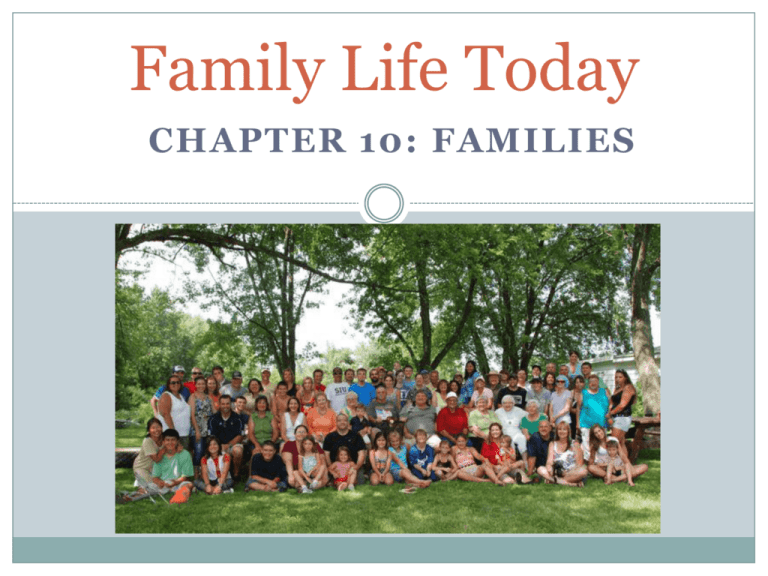
Family Life Today CHAPTER 10: FAMILIES Objectives Analyze the trends contributing to the changing family. Compare functions of the family in various cultures. Explain the relationship between family roles & responsibilities. List characteristics of a strong family. Describe 6 common family structures. Describe the 6 stages of the family cycle. What is a family? Family can be defined in many ways! According to the US Census Bureau the term family means a group of two or more persons, related by blood, marriage, or adoption, who reside together in a household. Families are as varied as people themselves. The Changing Family Activities and functions of families of the past are quite different than today. In early history, the family hunted and gathered in order to survive. Family members filled roles that provided survival. They lived in family groups. As agriculture evolved, families were able to set up permanent homes, and become independent as a family. The Changing Family The industrial revolution brought new pressures on society and the family. The father was typically the main provider and the mother was the full-time homemaker. People no longer worked solely for the survival of their own family. The technological age continues to affect families today. How Families Adapt to Change To be effective, families must be resilient. Families must be prepared to cope with the effects of a technological society. Although technology makes life easier, it presents a challenge to families at home and at work. At work-must keep up the technological advances. At home-important family functions displaced Family Functions in Various Cultures Families take many forms, but the functions they perform are the same from culture to culture. Families Provide: Economic support Education (religion) Love & Affection Nurturance Children (procreation Protection Recreation Provide Physical Needs To the best of their abilities, families provide the necessities of life such as food, clothing, shelter, furnishings, and health care. Education From the moment of birth, children are taught the ways of their culture by their families. Families teach children how to speak a language, how to take care of themselves, and how to get along with others. Families also convey their beliefs about religion to their children. Provide Love & Affection An important family function is to provide an emotional “safe haven” for family members. They know their needs for love, affection, and acceptance will be met. Nurturance The family provides the environment for nurturing the social skills of children, which allows them to function in the world. Families teach, mostly by example, the difference between acceptable and unacceptable behavior. As a result their children can take their places as productive members of society. Procreation Through procreation (reproduction), couples bring the members of the next generation into the world. Although a male-female bond forms the foundation for parenting the family life across cultures, marriage forms may differ widely. Protection Adult family members are responsible for the care of all family members. Responsible parents provide protection from harm, encourage good health and safety habits, form wholesome friendships, and avoid situations in which they are likely to become victims of crime. Recreation Sports, games, and other recreational pursuits provide family members with relaxation and physical exercise. These activities provide children with opportunities to learn communication skills and good sportsmanship. Roles & Responsibilities of Family Members Members of families have certain roles. There are given and chosen roles. A given role is a role acquired when a person is born into a family (son, daughter, brother, sister) A chosen role is a role a person voluntarily assumes (husband, wife, father, mother) Roles & Responsibilities of Family Members Roles are defined by responsibilities. How well people fulfill these responsibilities determines how well they perform their roles. Your role expectations for your future family are influenced by the roles played in your family today. It is important to understand people’s role expectations, especially when entering into marriage. Functional & Dysfunctional Families Functional Family – Family system in which all family members fulfill their roles and responsibilities. Dysfunctional Family – Family system in which one or more family members do not fulfill their responsibilities, throwing the system out of balance. Characteristics of Strong Families Respect for individual uniqueness Trust Sense of play and humor Shared responsibility Ability to recognize right and wrong The belief in upholding family traditions The belief in the importance of healthy interaction among members Shared belief in the importance of a religious or philosophical foundation Family Structures As society changes, new family structures emerge. Today there are many different family structures. There is no one best structure as long as the family is performing its functions and members are fulfilling its roles. There are six common structures. Two-Parent Family Married couple and their biological children Social activities often center around the family. Also referred to as nuclear family. Less than ¼ of American families consist of married couples with children. The Single Parent Family Occurs as a result of divorce, separation, death, or having children outside of marriage. Growing faster than any other family form. About 1/8 of all families are singleparent. Most single parents do not plan to be single parents. A sing parent faces the strain of being the sole head of the household (time, energy, money, etc.) Parents Who are Single as a Result of Desertion, Divorce, or Death Challenge of reshaping their own lives and the lives of their children under difficult circumstances. Time, effort, & cooperation, of all family members to reestablish secure family unit. Unwed Parents Many unwed mothers are choosing to keep their babies rather than arranging for adoption. A woman who keeps her baby should recognize her true reasons for doing so. Her reasons affect the way she behaves as a mother. Unwed fathers can choose to raise the child also. Single Parents by Adoption A person’s background will be investigated The reasons for wanting to adopt will be questioned The person must be able to provide the child with adult contacts of the opposite sex The Stepfamily Major structure in our society. Stepfamily – Family structure in which either or both spouses have been married before and may have one or more children from the previous marriage. Relationships in stepfamilies may be complicated. The Extended Kinship Family Extended kinship family – Family structure in which several generations of a family live together. More common in foreign countries. Advantages Interaction between family members of all age groups Aging members have an honored position The Foster Family Foster Parenting – System that provides children with substitute families while their parents are unable to care for them. Parents may not get along, parents may be unable to provide adequate care, children may have been abandoned. Families are must be licensed and are reimbursed for children’s expenses. Children come from all different backgrounds. The Adoptive Family Parents become legal parents of a child they bring into their home. May have been unable to have children on their own. Most couples prefer to adopt newborns. Adopting older children may be challenging. The Family Life Cycle Stages of change through which families pass as they expand and contract in size. Beginning, Childbearing, Parenting, Launching, Middle-Years, and Aging Stages Beginning Stage Begins with the establishment of the family unit when the couple marries Adjust to married life and separation from parents Establish feeling of interdependence Childbearing Stage Birth of children and focus turns to needs of the children New responsibilities Interpersonal relationships expand in family Role conflicts may occur Parenting Stage Reorganization of the family around school- age children Parents recognize individual needs of each child while sharing family goals Parent’s involved in children’s activities Teens seek more independence Launching Stage Children leave home (leave for college, careers, and marriage) Parents refocus on their relationship Parents relate to sons and daughters as adults Middle-Years Stage Prepare for retirement “Empty-nest” stage Parents provide emotional support as adult children establish their own families and careers Parent often become grandparents Prepare for retirement Aging Stage Retirement Focus on friendships, hobbies, interest, and travel Grand-parenting continues The End Assignment Using the provided crayons and paper: Create a Family Collage of your immediate family Mom, Dad, Brother, Sister, Grandma, Grandpa, Etc. You may also include others who live in your house that you are related to. You will color your family based upon the following: Blue – Blood Relative, that lives in your house Purple – Step Relative (step mom, dad, brother, sister, etc) Yellow – ½ Brother or Sister (share 1 parent) Green – Not Related Black – Blood related, but does not live in your house.

